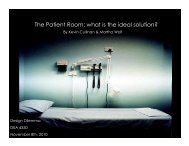The role of physical design and informal communication
The role of physical design and informal communication
The role of physical design and informal communication
Create successful ePaper yourself
Turn your PDF publications into a flip-book with our unique Google optimized e-Paper software.
• During an average eight-hour shift, the GN interacted 97 times at the nurses<br />
station, 81 times in the med room, <strong>and</strong> 74 times in the corridor. <strong>The</strong> average<br />
duration <strong>of</strong> interactions in the corridor (32s) was brief compared to interactions<br />
at the nurses station (51s) <strong>and</strong> in the med room (1:07).<br />
• <strong>The</strong> <strong>physical</strong> <strong>design</strong> <strong>of</strong> the med room – a room enclosed by four walls <strong>and</strong> a<br />
door – facilitated the abundance <strong>of</strong> social interaction that occurred there by<br />
serving as an acoustic <strong>and</strong> visual barrier between patients/visitors <strong>and</strong> staff.<br />
• “Knowledge Transfer” occurred mostly at the nurses station, med room, <strong>and</strong><br />
corridor, <strong>and</strong> was most <strong>of</strong>ten with the Orientor <strong>and</strong> nurses. Only 7% <strong>of</strong><br />
“Knowledge Transfer” occurred with a doctor.<br />
3.4 Learning <strong>and</strong> Gaining Competency<br />
Through observation <strong>and</strong> focused interviews, data was collected on the unit’s<br />
approach to GN orientation. A survey was used to assess the degree to which the unit<br />
supported <strong>and</strong> encouraged learning, from the perspective <strong>of</strong> both the GN <strong>and</strong> RNs. A<br />
Competency Rating Tool was used to collect weekly quantitative data on how GN<br />
competency changed over the course <strong>of</strong> the orientation period. <strong>The</strong> Competency<br />
Rating data was complemented by information obtained in focused interviews.<br />
3.4.1 <strong>The</strong> GN - Orientor Relationship<br />
In order to get the most out <strong>of</strong> the CWM tool data, it was important to gain<br />
insight into the unique relationship between the Orientor <strong>and</strong> the GN in this study. A<br />
quick look at the interaction data shows that the GN had less interaction with the<br />
Orientor – the <strong>design</strong>ated mentor <strong>and</strong> guide during orientation – than one would have<br />
predicted. It is not unreasonable to expect that most learning <strong>and</strong> teaching would be<br />
between the GN <strong>and</strong> her Orientor, yet most <strong>of</strong> the “Knowledge Transfer” interactions<br />
91







